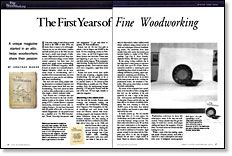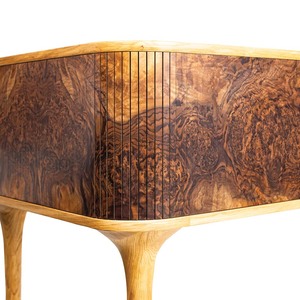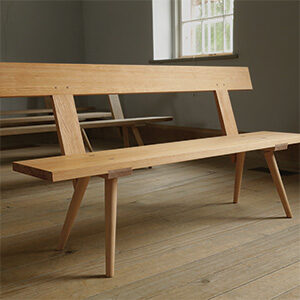The First Years of Fine Woodworking
A unique magazine started in an attic helps woodworkers share their passion
If you were trying to learn how to work wood in the 1960s or early 1970s, you knew what it meant to be self-taught. Chances are you not only lacked a mentor and well-trained peers in the field, but you also faced a nearly total drought of information. High schools had basic shop classes, and community college courses tended toward carpentry, but there were few schools that taught serious woodworking. Aside from Workbench magazine, which focused on simpler do-it-yourself projects, Popular Mechanics, which ran an occasional article on woodworking, and a handful of dry instructional texts, you were pretty much on your own for any information about woodworking.
But more and more young people seeking alternatives to traditional corporate and professional careers found their way into woodworking. They were joined by artists as well as older professionals in mid-career who sought a creative weekend outlet.
Paul Roman was a hobbyist who had long been frustrated by the lack of information in print on the subject. In the early spring of 1975, General Electric’s corporate restructuring eliminated several jobs, including Roman’s. He had been frustrated with his public affairs job, so he was not entirely disappointed. At one point he had run a classified ad in The Wall Street Journal: “Bored, blue-chip bureaucrat seeks new assignment.” It got only three responses, all from headhunters.
Roman was 44. He had four girls in school, a boy in diapers and $2,800 in the bank. He was completing a house in Newtown, Conn., an old New England town where farmers and their John Deeres were just beginning to give way to commuters and their station wagons. With unemployment looming, Roman had to find his new assignment quickly. That’s when he decided to start a magazine—right there in his new home.
Roman had toyed several years earlier with the idea of starting a magazine about woodworking. He had gotten as far as thinking up possible names: Cabinetmaker’s Journal, maybe, or The Journal of Fine Woodworking or possibly just Fine Woodworking. Now, the daydreaming became planning. GE had given Roman until the end of the year. He had eight months to make his magazine.
Discovering a rich, hidden world
Over the next few months, Roman spent evenings and weekends seeking out woodwork and woodworkers. Roaming from Virginia to New Hampshire, he visited woodshops and craft shows, bookstores and libraries, schools with woodworking programs and museums with furniture collections Along the way, his horizons widened. His own training in woodwork had been confined to his junior high school shop class in the 1940s and what he’d been able to pick up by trial and error. Sharing the general mindset of the time, he had thought that if you couldn’t make something with power tools, you could not make it. But as he traveled, he discovered a richer, hidden world where craftsmen using a broad variety of tools and techniques achieved breathtaking results. His notebooks from those months brim with names that would soon become familiar to readers of Fine Woodworking: Tage Frid, R. Bruce Hoadley, Alphonse Mattia, Bill Keyser, Jere Osgood.
By late spring, feeling confident that he had discovered a solid group of craftsmen he could draw upon for articles, Roman turned his attention to mastering the parts of publishing about which he knew little or nothing: distribution, printing, paper costs, typesetters, marketing and advertising. Toward the end of that summer, he sat down to the most pivotal task of all—writing the promotional mailer, the invitation to subscribe. If the promo piece failed, so would the whole undertaking.
His vision of the magazine had crystallized, so he was able to write a strong letter that laid out the attributes of his new quarterly. To this point, Roman and his wife, Jan, had been able to do almost everything themselves. But now, wanting to send out 20,000 copies of the letter, they enlisted their children and friends to paste labels and sort by zip code.
As family projects go, this one entailed fairly high risks. At 14 cents apiece, the 20,000 letters cost $2,800 to mail. That took care of the Romans’ savings account. The letter asked subscribers to pay $8 up-front for a year’s subscription to the magazine, sight unseen, and promised that the first issue would be delivered in November. Sight unseen, indeed! As the letters left the Newtown post office at the end of August,
Roman did not have a single article in hand. Based on industry standards, Fine Woodworking could hope for about 800 subscription orders if the idea was well-received. Roman decided that if he got that many, he would do a second, much larger mailing and launch the magazine. If he got fewer, he would return the checks and start looking for a job.
Within a week of the first mailing, stacks and stacks of letters arrived, each with a check for a year’s subscription and many with notes of delighted encouragement scribbled on the subscription form. After just four days of returns, the target of 800 subscriptions was reached. And the letters kept coming, eventually racking up 3,000 subscriptions.
This was wonderful news, but there was barely time to digest it. Roman had two months to assemble the issue and get it out the door. He spent September visiting his authors, coaxing manuscripts out of them and taking photographs. Meanwhile, for a second mailing, their first few employees were hired to type envelopes in the magazine’s headquarters: the Romans’ attic. “There was a lot of enthusiasm,” said Ruth Dobsevage, who was one of the first two people hired and who has been with the company ever since. “It was like a family deciding to do a family project at that point. Much more like that than like a business.” The crew in the attic sent out another 100,000 letters, which would generate another 15,000 paid subscriptions. Roman spent an October vacation in the attic as well. In one long blur of editing, layout and paste-up, he put together more than a dozen articles and emerged at the end of the month with a completed magazine. On Nov. 1, the premier issue of Fine Woodworking went to press with a print run of 25,000 copies.
A few defining decisions
Roman’s aspirations for the magazine were modest. If things broke right, perhaps it would eventually attain a circulation of 25,000. As it happened, he discovered that he’d brought water to the desert. The 25,000 mark in circulation passed with the first issue. One-hundred-thousand flashed by after three years, and circulation continued to climb. By 1985, the magazine had more than a quarter-million readers.
Given that most new magazines struggle to break even by the fifth year, why did this magazine blast off into profitability with its first issue and then continue to grow? Timing was part of the reason. And a cluster of key decisions determined Fine Woodworking’s unique character and enabled its success. They were unorthodox choices, yet many have remained unaltered for 25 years and have been applied to every subsequent magazine that The Taunton Press has published.
A magazine without “writers”
The most profound move was to make a magazine written by its readership. If the magazine was to be full of excellent information, woodworkers themselves would be the best sources for it. As Roman wrote in a letter to the readers in issue #1: “What we’re looking for primarily is expertise—the writing usually has a way of working itself out.” Over the years, this policy has proven to be the magazine’s greatest strength.
Readers first—Most magazines rely on advertising for the lion’s share of their revenue. Under that model, readers are essentially bait to attract advertisers. But Fine Woodworking would be a magazine primarily supported by its readers, and Roman thought the magazine’s advertising should be a service to the readers, not the other way around. So, from the beginning the magazine accepted only endemic advertising—ads for products and services related to woodworking. To keep from being beholden to a few large advertisers, the magazine set out to attract many smaller advertisers as well. Particularly in its first 10 years, when other sources for tools and equipment were relatively scarce, the ads in Fine Woodworking were an irreplaceable resource for craftsmen.
It should be archival—Roman did all he could to give Fine Woodworking a distinctive look and heft. Having designed a logo for it that incorporated a set of dovetails, he wasn’t going to settle for a magazine put together with nails. He decided it would be printed on heavy, coated paper and have an unusual, large format. He chose a stately typeface and decided to do the magazine in black and white for the blend of dignity and documentary grittiness it offered, much like Scientific American at the time, and also for its impact in a world of color magazines.
Photography by editors—An avid photographer, Roman decided to shoot his own photos. At first it was for purely cost-saving reasons. but it was soon clear that photography shot by woodworker-editors added to the authenticity, immediacy, and informational quality of the magazine.
No advertisement on the back cover—Sometimes good decisions are ad hoc. Because of its visibility, the back cover is the spot most coveted by advertisers. The ad that was to run on the back of Fine Woodworking’s first issue was so unattractive that Roman moved it inside, put a short article on the back cover, and declared a policy that no ad would ever appear there.
Finding Frid
When Fine Woodworking first came out, there was precious little fine woodworking being done in the United States. A country that had once produced Hadley chests, Newport breakfronts and Shaker wardrobes had lost almost all of its furniture-making expertise. To make his magazine a success, Roman needed someone who could link it to that vanished world of craftsmanship. As John Kelsey, a long-time chief editor of the magazine, described it, Roman knew the magazine needed “somebody who demonstrably had touched the hand. Who had been taught by master-to-apprentice, father-to-son and as far back into the mists as you could see.”
Early in his searches, Roman had the great fortune to find just that person: Tage Frid, professor of woodworking at Rhode Island School of Design (RISD). Frid had served a traditional European apprenticeship in his native Denmark starting at age 13 and then worked in a series of woodshops in Denmark and Iceland before he was recruited to teach in the United States in 1948, when he was 33. “What Frid knew,” Kelsey said, “was the distillation of a couple of thousand years.” In addition, Frid had the inclinations of a teacher, which proved to be an incalculable advantage in his work for Fine Woodworking (see the story about Frid on p. 80).
Frid’s articles, with their mixture of rock-solid authority and bantering tone, were an instant success. “He was a born teacher,” said Roman, “and his primary concern was to communicate.” Frid’s myriad connections in the field were also vital to the magazine. Scores of Frid’s students and students of his students would become authors for the magazine. And Frid—along with R. Bruce Hoadley, a wood technologist at the University of Massachusetts who has been a contributing editor to Fine Woodworking since issue #2—was one of the key advisers, providing detailed feedback on the magazine in the early days (see the story about Hoadley on p. 78).
Magazine on a mission
If Paul Roman sketched a plan for Fine Woodworking, John Kelsey filled in many details. Kelsey was 28 and a year out of the woodworking program at Rochester Institute of Technology (RIT) when Roman hired him in August 1976, in time to help edit the fifth issue of the magazine. Within a month, Kelsey had taken over the editorial chores, enabling Roman to step back from the day-to-day making of the magazine and assume the role of publisher. As Kelsey sees it now, the magazine’s mission was “to map the field. To show you just how broad this is, and just how far into human affairs it cuts.”
Kelsey, who now runs Cambium Press, a publisher and bookseller in Bethel, Conn., arrived at Fine Woodworking with 10 years’ of experience working on newspapers around the country. He also brought with him a style of writing that was clear and compelling, whether he was describing a turning conference or a tenoning jig. “I felt that my role was to be there on behalf of all those fellows who couldn’t be,” he said. “And so I should write about it in a way that they could understand. I should try and open a window.”
His first year on the job, Kelsey edited Fine Woodworking virtually single-handedly, as Roman had done before him. When the magazine went from quarterly to bimonthly in 1978, however, that was no longer possible. In the following years, Kelsey led a small staff. His hiring principle was to select people with a talent for writing but a passion for woodworking rather than hiring seasoned journalists. It is a hiring philosophy that continues to this day.
The wisdom of this approach was abundantly evident in the magazine. Every new issue seemed to turn up another fascinating woodworker, either historical or contemporary. The magazine excelled at singling out and describing distinguished work. At the same time, it poured out articles on hundreds of technical topics never before or only poorly covered in print, from steam bending and stack lamination to dust collection and solar kilns.
Rick Mastelli, Kelsey’s first assistant editor and the first head of Taunton’s video effort, added excellent articles of his own on period furniture makers, woodworking exhibitions, and regionally important woodworkers. When other projects at the growing company took Kelsey away from daily oversight of Fine Woodworking in those early years, Mastelli filled in and kept the pipeline of articles flowing.
Roughly speaking, Kelsey’s editorial direction spoke to the younger generation in Fine Woodworking’s audience, the so-called hippie woodworkers—politicized, passionate, struggling to learn the craft and make a living from it. Roman, on the other hand, 16 years older, identified more easily with the people for whom woodworking was a form of relaxation, not a lifestyle. For his part, Roman said Kelsey “did a little different magazine than I would have done, but overall we always had the same view of it. We had slightly different interests—he liked the quirky a little more than me. But he did a superb job.” There was, by all accounts, always a push and pull between editor and publisher, which produced a
vibrant magazine.
A readership both unified and divided
A similar tension has always been evident in Fine Woodworking’s readership. From its first issue, Fine Woodworking has attracted a group of readers united in their passion for woodworking but divided in any number of other ways: between older readers and younger, experts and beginners, power-tool junkies and hand-tool
absolutists, makers of period and contemporary furniture, professionals and amateurs, art furniture makers, and devotees of pure function. The diversity of the readership makes it impossible to satisfy, but the attempt keeps the magazine vital.
Every once in a while an item in the magazine starts a brush fire in the Letters column. Perhaps the most enduring controversy in the magazine’s history was sparked by an
innocent-looking cabinet pictured on the back cover of issue #24. At first glance, Garry Knox Bennett’s padauk showcase cabinet seems inoffensive. You have to look closely to see the source of the controversy. There it is, in the upper door—a big, fat, bent nail hammered into an otherwise pristine cabinet. Bennett’s nail perfectly polarized two factions in the readership, mortally offending some, who took it as a desecration of craftsmanship, and delighting others, who saw it as an inspired artistic gesture (you can read some of these opinions in the Letters column on p. 10).
Another division in the readership was revealed by an article in issue #98, a profile of Norm Abram and the television show New Yankee Workshop. If the nail controversy pitted conservatives against iconoclasts, the storm over Norm was something different: a battle over standards of craftsmanship that prompted charges of elitism on one side and “dumbing down” on the other. “Norm’s picture on the cover of Fine Woodworking is like Phyllis Diller on the cover of Playboy,” one reader wrote. But another answered, “New Yankee Workshop teaches viewers basic woodworking without making the viewer feel stupid.” The flap caused by that article provoked a hundred letters and took half a year to settle down. Like the nail in Bennett’s cabinet, the profile of Norm raised issues that were never in danger of being resolved.
For all their diversity, Fine Woodworking readers are united in their passion for their craft. When Roman wrote his promotional letter 25 years ago, he started it with, “Woodworkers are a quiet lot.” At the time, it seemed so. But after witnessing the lively exchange of opinions his magazine has generated over the years and the fierce loyalty that has made it endure, perhaps Roman would rewrite that sentence to read: “Woodworkers are a passionate lot.”



















Log in or create an account to post a comment.
Sign up Log in